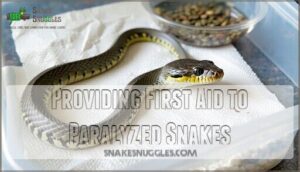This site is supported by our readers. We may earn a commission, at no cost to you, if you purchase through links.
 You might wonder, can snakes be paralyzed? Yes, they can.
You might wonder, can snakes be paralyzed? Yes, they can.
Paralysis in snakes happens for several reasons—spinal injuries, infections, toxins, or nutritional deficiencies. You’ll notice signs like dragging part of the body, odd posture, or trouble moving and eating.
Quick action is key, since some causes are treatable if you act fast. A vet can diagnose the issue, offer medication or supportive care, and guide you on temperature and feeding.
Prevention is all about safe habitats and regular checkups. Notably, some snakes can even paralyze humans with their venom. There’s more to this story than meets the eye.
Table Of Contents
- Key Takeaways
- Can Snakes Become Paralyzed?
- Snakes That Can Paralyze Humans
- How to Help a Paralyzed Snake
- Can Snake Bites Cause Paralysis in Humans?
- Real-Life Examples of Snake Paralysis
- Frequently Asked Questions (FAQs)
- Can a snake get paralyzed?
- What snakes cause temporary paralysis?
- Can snakes become paralyzed?
- What snakes can paralyze?
- How to help a paralyzed snake?
- Can snake bites cause paralysis?
- What are common signs of paralysis in snakebite victims?
- Can antivenom reverse paralysis caused by snake venom?
- Are certain snake species more likely to cause paralysis?
- Can paralysis from snakebites be treated with nasal sprays?
- Conclusion
Key Takeaways
- You should watch for paralysis signs in your snake – dragging body parts, abnormal posture, difficulty moving, and eating problems indicate potential nervous system damage that requires immediate veterinary attention.
- Multiple causes can paralyze your snake – spinal injuries from falls or improper handling, viral infections like inclusion body disease, exposure to neurotoxic venom from other snakes, and physical trauma all threaten your pet’s mobility.
- Certain venomous snakes can paralyze you – cobras, kraits, mambas, coral snakes, and sea snakes inject neurotoxic venom that blocks nerve signals, causing muscle weakness and potentially fatal respiratory paralysis without prompt antivenom treatment.
- Quick action saves lives in both scenarios – whether your snake becomes paralyzed or you’re bitten by a neurotoxic species, immediate professional medical intervention dramatically improves recovery chances and prevents permanent damage.
Can Snakes Become Paralyzed?
Yes, snakes can become paralyzed through various causes including spinal injuries, viral infections, and exposure to neurotoxic venom from other snakes.
When paralysis occurs, it substantially impacts a snake’s ability to move, hunt, and perform essential bodily functions like digestion.
Snake Paralysis Causes
Snake paralysis stems from several key causes that can devastate your pet’s nervous system. Spinal injuries from falls or improper handling can instantly trigger paralysis, while viral diseases like inclusion body disease (IBD) progressively attack the central nervous system.
Even venom toxins from other snakes can cause neurological disorders in your snake. Reptiles can also carry bacteria that cause zoonotic disease transmission to humans.
- Spinal injuries from vertebral damage during handling or falls
- Viral diseases including IBD paralysis and respiratory infections
- Venom toxins from interspecies encounters causing neurological disorders
- Infectious stomatitis spreading to affect nerve function
- Physical trauma to the vertebral column disrupting nerve signals
Snake Paralysis Symptoms
Recognizing a snake’s paralysis symptoms helps you respond quickly when your reptile needs urgent care.
Snake paralysis symptoms include visible signs like facial drooping, muscle tone loss, limb numbness, breathing difficulty, and movement loss.
Watch for these critical indicators:
- Lethargy and loss of coordination during normal activities
- Difficulty moving specific body sections or complete immobility
- Labored breathing patterns or respiratory distress
Snake Paralysis Treatment
Treatment options for snake paralysis depend on the underlying cause, with timing being critical for recovery.
Here’s your breakdown:
Treatment Effectiveness Accessibility
Antivenom availability remains the gold standard but requires immediate administration.
Respiratory muscle paralysis is a major concern in snakebite envenoming and may require ventilation.
Physical rehabilitation and supportive care improve your snake’s paralysis prognosis substantially when combined with proper snake vet guidance.
Snake Paralysis Prevention
Prevention beats treatment in the context of snake paralysis. You can’t always control what happens, but smart preparation makes a huge difference.
Key prevention strategies include:
- Safe Enclosures: Remove hazards and create escapeproof containers
- Handling Techniques: Use proper two-handed support during snake interactions
- Regular Checkups: Schedule veterinary visits for early detection of health issues
- First Aid Training: Learn emergency response for snake injury prevention
Safe handling practices and hazard removal substantially reduce paralysis risks in captive snakes.
Snakes That Can Paralyze Humans
While we’ve covered how snakes can become paralyzed, it’s equally important to understand which snakes can cause paralysis in humans through their venom.
Many venomous species produce neurotoxic compounds that target the nervous system, blocking nerve signals and potentially causing life-threatening paralysis in bite victims.
Venomous Snakes That Cause Paralysis
When you’re facing venomous snakes, understanding which species deliver paralytic toxins becomes critical for safety.
Geographic distribution affects your risk exposure, while venom composition determines paralytic effects.
Neurotoxins in elapid snakes target nerve transmission, causing snake paralysis through specialized venom delivery systems.
- Inland Taipan – Australia’s most lethal, with devastating neurotoxic venom composition
- Eastern Brown Snake – Second-most venomous, found across eastern Australia
- Black Mamba – Africa’s fastest killer, delivers rapid-acting paralytic toxins
- Tiger Snake – Australia/New Guinea native with potent neurotoxins
- Boomslang – African tree snake with unique venom delivery mechanism
Cobra and Krait Venom Effects
Why do cobra and krait venoms affect you differently? Both contain powerful neurotoxins that trigger snake paralysis, but their mechanisms vary substantially.
Cobra venom causes rapid respiratory failure through neurotoxin mechanisms, while krait venom leads to gradual muscle weakness with delayed paralysis onset.
Alpha-bungarotoxin plays a key role in this process.
Venom potency differs between species, affecting recovery factors and treatment success, which is influenced by species variation.
Species variation means cobra bites show immediate symptoms, but krait envenomation may appear mild initially before severe paralysis develops hours later.
Other Snakes That Can Cause Paralysis
Beyond cobras and kraits, several other venomous species deliver paralyzing bites.
Sea Snake Paralysis from yellow-bellied sea snakes causes rapid respiratory failure.
Coral Snake Venom contains potent neurotoxins affecting nerve transmission.
Mamba Neurotoxins from black mambas produce descending paralysis within minutes.
Taipan Paralysis occurs through pre-synaptic neurotoxins.
Death adders and some vipers also cause Krait Venom Effects-like symptoms, making antivenom essential.
How to Help a Paralyzed Snake
When you discover a snake showing signs of paralysis, your immediate actions can determine whether it survives or suffers permanent damage.
Quick identification of symptoms and proper emergency care create the foundation for successful treatment and recovery.
Identifying Snake Paralysis
When you suspect a snake is paralyzed, quickly check for key warning signs. Early symptoms include difficulty moving, abnormal posture, and slow responses. Movement assessment reveals coordination loss and muscle weakness. Reflex testing shows delayed reactions to touch or sound.
Here’s how to identify snake paralysis:
- Observe muscle tone – Look for limp, floppy body segments or unusual stiffness that indicates neurological damage
- Test basic reflexes – Gently tap near the snake’s head or tail; paralyzed snakes show minimal defensive responses
- Check breathing patterns – Watch for labored, irregular, or shallow breathing that signals respiratory muscle involvement
Diagnostic tools aren’t needed for basic identification, but veterinary examination confirms paralysis severity and underlying causes. Additionally, be aware that unusual resting positions can also be indicative of neurological issues.
Providing First Aid to Paralyzed Snakes
Once you’ve identified snake paralysis, Safe Containment becomes your priority.
Move the snake to a quiet, secure container with Soft Bedding like paper towels to prevent injury.
Maintain Temperature Regulation at 75-85°F and provide Hydration Methods through a shallow water dish.
A suitable option might be a specialized holding container.
Avoid handling or feeding the paralyzed snake.
Focus on creating a stable environment for Vet Transport preparation.
Seeking Veterinary Care for Paralyzed Snakes
After first aid, immediate veterinary care is critical for your snake’s recovery.
Find a qualified reptile vet experienced with snake paralysis cases. Emergency transport your snake safely to the clinic for diagnostic tests and professional assessment.
The vet will determine prognosis factors and recommend supportive care or paralysis treatment options.
Consider emergency care products for your snake’s health. Choosing a vet with reptile expertise substantially improves recovery outcomes.
Can Snake Bites Cause Paralysis in Humans?
Snake bites from venomous species can absolutely cause paralysis in humans, making this a serious medical emergency.
When neurotoxic venom enters your system, it attacks your nervous system and can quickly lead to muscle weakness, breathing difficulties, and potentially fatal paralysis if you don’t receive immediate treatment.
Snake Venom and Paralysis
When venom enters your bloodstream, it becomes a biological warfare agent.
**Venom hijacks your nervous system like a deadly puppet master pulling strings.
Snake venom neurotoxins target your nervous system, disrupting nerve signals that control muscle movement and breathing.
Different species pack varying venom potency, creating distinct paralysis mechanisms:
- Neurotoxic blockade: Venom blocks nerve-muscle communication, causing flaccid paralysis
- Respiratory shutdown: Diaphragm muscles stop working, leading to breathing failure
- Progressive spread: Paralysis typically starts at bite site, then spreads systemically
Antivenom efficacy depends on species identification and treatment timing.
Symptoms of Snake Bite Paralysis
Snake bite paralysis symptoms develop rapidly, often within minutes.
Muscle weakness spreads through your body, making movement and speech difficult.
Breathing difficulty intensifies as respiratory muscles fail. Facial drooping becomes noticeable, while limb numbness spreads.
Your vision blurs, and loss of coordination impairs basic functions.
Snake venom neurotoxins attack your nervous system systematically.
Treatment for Snake Bite Paralysis
When paralysis strikes from a snake bite, antivenom remains your lifeline.
Antivenom efficacy depends on rapid administration, ideally within hours of the bite. Medical teams may use nasal neostigmine for certain cobra bites, though it’s less effective against krait venom.
Respiratory support becomes essential when breathing muscles fail. Recovery often requires physical therapy and long-term care to restore full function.
Snakes can also suffer from illnesses, and bacterial infections require antibiotics.
Real-Life Examples of Snake Paralysis
Understanding paralysis in snakes becomes clearer when you examine documented cases from veterinary practice and research.
These real-world examples demonstrate how different causes lead to paralysis symptoms and highlight the critical importance of immediate professional intervention for successful recovery outcomes, which is essential for successful recovery.
Case Study of a Snakebite Victim
A 34-year-old male from rural India experienced a life-threatening encounter with a common krait (Bungarus caeruleus) while sleeping. The bite on his right ankle initially seemed minor, but within hours, his world turned upside down.
What seemed like a minor ankle bite quickly became a nightmare of spreading paralysis.
This case demonstrates how quickly neurotoxic venom can overwhelm the human body.
Here are 4 critical aspects of this snakebite victim’s experience:
- Victims Background: Rural setting with limited immediate medical access, no prior neuromuscular conditions
- Envenomation Details: Ankle bite during sleep, 3-hour delay before hospital arrival
- Paralysis Onset: Progressive weakness began within 4 hours, ptosis developed rapidly
- Treatment Efficacy: 20 vials of polyvalent antivenom administered within 6 hours proved successful
The patient’s snake paralysis progression followed a classic descending pattern. Respiratory muscle weakness required mechanical ventilation by hour 6, while complete limb flaccidity occurred at 8 hours.
Despite severe venom effects, proper antivenom treatment and supportive care enabled full snake recovery within 5 days.
Medical Assessment and Treatment of Snakebite Paralysis
When medical teams evaluate snakebite victims, Antivenom Efficacy becomes the top priority.
Healthcare providers follow strict Veterinary Protocols to identify neurotoxins and administer treatment. Respiratory Support equipment stands ready as teams implement Neostigmine Trials for muscle function.
Rehabilitation Strategies help patients regain strength after antivenom reverses snake paralysis from venomous snakebite encounters.
Immediate action includes calling 911 to guarantee a rapid medical response.
Importance of Prompt Diagnosis and Treatment
Time saves lives when snake paralysis strikes.
Early intervention dramatically improves recovery chances and reduces long-term effects.
Veterinary urgency can’t be overstated – snake symptoms worsen rapidly without proper snake treatment.
Finding a qualified snake vet immediately starts minimizing damage.
Don’t wait – paralysis treatment works best within hours, not days.
Frequently Asked Questions (FAQs)
Can a snake get paralyzed?
Ever wondered if these limbless creatures can lose their ability to move?
Yes, snakes can become paralyzed from spinal injuries, viral diseases like inclusion body disease, venom exposure, or physical trauma affecting their nervous system.
What snakes cause temporary paralysis?
You’ll encounter neurotoxic snakes like cobras, kraits, mambas, coral snakes, and sea snakes that cause temporary paralysis.
Their venom blocks nerve signals, but recovery’s possible with prompt antivenom treatment and supportive care, which can lead to a full recovery from the paralysis.
Can snakes become paralyzed?
Studies show that 30% of captive snakes experience neurological issues during their lifetime.
Yes, snakes can become paralyzed through spinal injuries, viral infections like inclusion body disease, or exposure to neurotoxic venom from other snakes.
What snakes can paralyze?
Venomous snakes with neurotoxic venom can paralyze prey and threats. You’ll find cobras, kraits, mambas, coral snakes, sea snakes, and some rattlesnakes possess this ability through specialized toxins.
How to help a paralyzed snake?
Like a snake shedding its skin needs time and care, a paralyzed snake requires immediate veterinary attention.
Transport it safely in a secure container, provide soft bedding, follow feeding recommendations, and make certain respiratory support while healing.
Can snake bites cause paralysis?
Yes, snake bites can cause paralysis.
Neurotoxic venoms from species like cobras, kraits, and mambas attack your nervous system, blocking nerve signals to muscles and potentially causing respiratory paralysis, which can be fatal without treatment.
What are common signs of paralysis in snakebite victims?
Your body’s alarm bells go haywire when snake venom hits your nervous system.
You’ll notice muscle weakness, difficulty breathing, drooping eyelids, slurred speech, and trouble swallowing as paralysis spreads through your body.
Can antivenom reverse paralysis caused by snake venom?
Antivenom can reverse paralysis from snake venom when administered promptly. It’s highly effective but has limited accessibility. Quick treatment substantially improves recovery outcomes and minimizes paralysis duration.
Are certain snake species more likely to cause paralysis?
Like a venomous spider’s bite, certain snake species pack neurotoxic venom that’s particularly effective at causing paralysis.
Elapids, including cobras, mambas, and coral snakes, you’ll find are the main culprits here, delivering potent neurotoxins that block nerve signals to muscles.
Can paralysis from snakebites be treated with nasal sprays?
Nasal neostigmine shows promise for treating snakebite paralysis, but it’s still experimental. You’ll need immediate veterinary care and potentially antivenom for effective treatment, as respiratory support remains essential.
Conclusion
Like a ship traversing treacherous waters, understanding whether snakes can be paralyzed equips you with vital knowledge for both snake care and human safety.
Yes, snakes can indeed become paralyzed through various causes including spinal injuries, infections, and toxins.
Recognition of symptoms like dragging movements and postural abnormalities enables prompt veterinary intervention.
Meanwhile, certain venomous species possess the ability to cause paralysis in humans through neurotoxic bites.
Swift medical attention remains essential in both scenarios for ideal outcomes.














